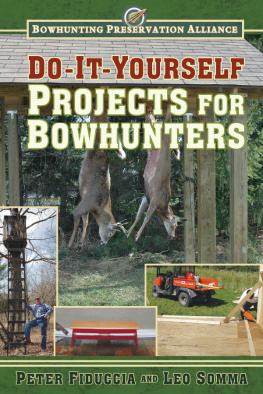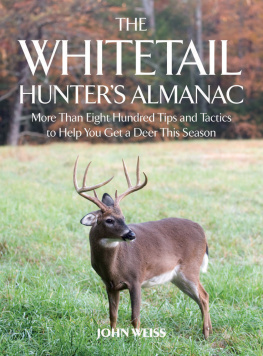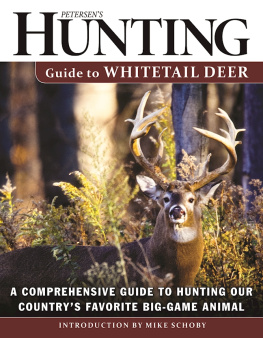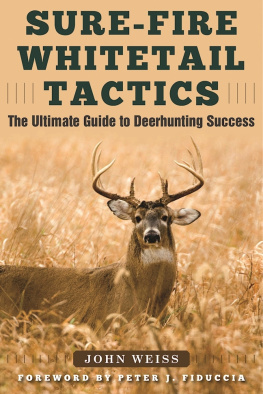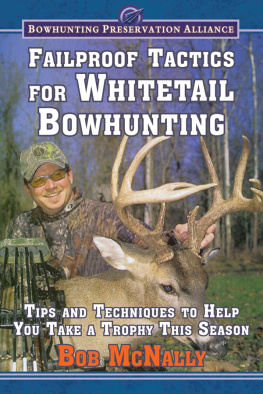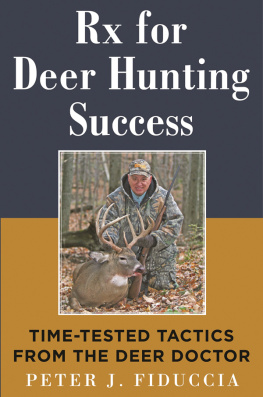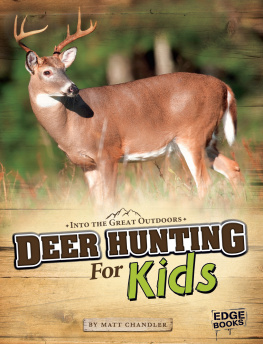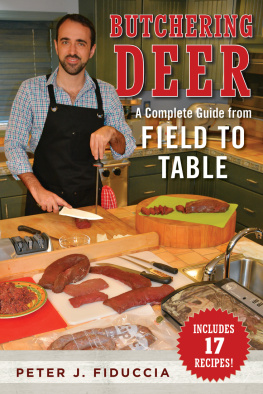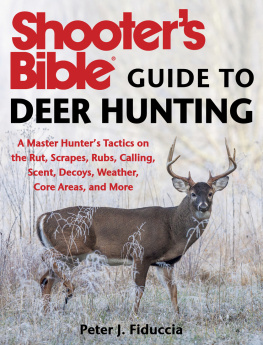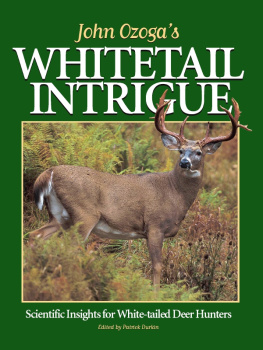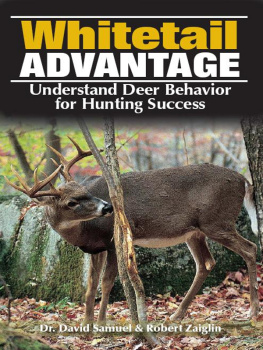

Copyright 2013 by Peter Fiduccia
A special thanks to wildlife photographer Ted Rose for his deer images.
All Rights Reserved. No part of this book may be reproduced in any manner without the express written consent of the publisher, except in the case of brief excerpts in critical reviews or articles. All inquiries should be addressed to Skyhorse Publishing, 307 West 36th Street, 11th Floor, New York, NY 10018.
Skyhorse Publishing books may be purchased in bulk at special discounts for sales promotion, corporate gifts, fund-raising, or educational purposes. Special editions can also be created to specifications. For details, contact the Special Sales Department, Skyhorse Publishing, 307 West 36th Street, 11th Floor, New York, NY 10018 or
Skyhorse and Skyhorse Publishing are registered trademarks of Skyhorse Publishing, Inc., a Delaware corporation.
www.skyhorsepublishing.com
10 9 8 7 6 5 4 3 2 1
Library of Congress Cataloging-in-Publication Data is available on file.
ISBN: 978-1-62636-168-3
eISBN: 978-1-62873-569-7
Printed in China
I dedicate this book to my identical twin cousins, Leo and Ralph Somma. You are my best friends and lifelong hunting companions. Deer season wouldnt be the same without us hunting together. From our wake-up call by a Felix the Cat alarm clock blasting reveille, to eating breakfast while the intercom plays Another One Bites the Dust by Queen, to the evening ribbing sessions, to the all-too-early sounds of snoring on the reclinersthese are all traditions I look forward to sharing with you both each deer season.

I even look back fondly on the Ultra Death Sauce incident with laughter. Despite it being extraordinarily searing and blistering hot, we all ignored the dire warning on the label that clearly states, Be warned: this sauce contains ingredients 800 times hotter than a jalapeno Chile. Use sparingly. Ultra Death should not be consumed without dilution, and mixed it into each of our meals thinking the resulting hopping-around-on-one-foot-screaming would surely be comical. Unluckily, it was me who ended up with a tad too much Death Sauce clandestinely mixed, undiluted, into my spaghetti sauce and pasta. Through completely unintended, I even enjoyed the two-day hospital stay which followed that gag!
Contents
DEER FACTS

Chapter One
Anatomy of the Rut: Real-World Timing
The whitetail deer breeding season, or rut, refers to the time frame when does are most fertile and receptive to accepting the amorous intentions of male deer. Unfortunately, there is a wide array of misinformation, rumors, and long-held myths about this important subject. Two of the most commonly held erroneous viewpoints are that the rut only takes place during cold weather and only lasts for a short period of time during November. The fact is that neither of these two notions is accurate. I can assure you that since I began hunting in 1964, I have discovered that rut information handed down from old-timers generally consists of unintended distortions, half-truths, and, in some cases, unequivocal misinformation.
For instance, the whitetails rut lasts months. At my seminars, many people are astonished when I tell them that as long as a buck has antlers attached to his head and a doe has not been successfully bred, both are willing and able to breed whether it is October, November, December, or even later.
The genesis of each phase of the rut occurs specifically in relationship to dates within the four latitude zones of the United States. If you include Canada, there are six latitude zones and if Mexico is added, there are nine. Latitudes are invisible horizontal lines that depict the angular distance in degrees, minutes, and seconds of a point north or

This image was taken on November 14th in Southern Indiana. November 10th to 15th are dates that consistently show up as peak days of breeding activity throughout North America within the latitudes of 3750 north and the longitudes of 50125 west
south of the equator. They are also referred to as parallels. Within each of the parallels in North America, the rut takes place, whether it is cold or warm outside, with surprising regularity. Cold weather only helps generate daytime activity. In other words, when the weather turns cold, bucks are more likely to move about searching for does during the day than in warmer temperatures. The chilly weather spurs their libido and makes them more inclined to feel romantic. This phenomenon can cause the breeding cycle of whitetail deer to take place over a longer period of time than most people believe.
The internal trigger that causes deer to be aware of the onset of the rut is the preorbital gland, located in the corner of each eye. It senses cycles of waning light levels, or photoperiods, that begin in early autumn. The preorbital gland is a paired exocrine gland found in a majority of hoofed animals that is similar to the lacrimal gland found in humans. The preorbital glands are black trench-like slits of nearly bare skin extending from the medial canthus of each eye, which are lined by a combination of sebaceous and sudoriferous glands. They produce secretions that contain pheromones and other chemical compounds. All ungulates frequently deposit these secretions on overhanging branches by licking sticks, twigs, and grass as olfactory communications to other deer.
The preorbital gland serves different roles in different species. Pheromone-containing secretions from the preorbital gland might establish a buck or does hierarchy within its herd. As a buck or doe prepares for breeding season, they will mark vegetation within their home range with preorbital scent. Because of its critical role in scent marking, the preorbital gland is usually considered a Type A scent gland. Some biologists believe the preorbital glands might produce antimicrobial compounds to protect against skin pathogens.
The various secretions of chemicals trigger a bucks brain to recognize the start of the rut, and his testes begin to enlarge and descend, becoming more visible. With each passing day of waning light, the demeanors of deer, particularly adult bucks, go from tolerant and benign to irritable and aggressive. By the time the primary phase of the rut kicks in, a bucks testes reach their greatest size.
No matter where whitetails roam, the rut corresponds closely to the time when most female deer are fertile and, therefore, most apt to be successfully bred. If, for whatever reason, a doe is not successfully bred during the peak rut, she will come into her estrus cycle every twenty-eight to thirty-two days.
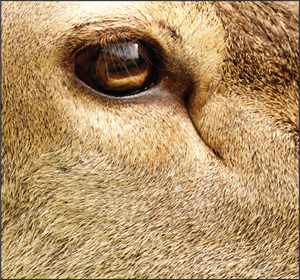
As soon as the preorbital gland detects a shortening of daylight, it triggers a release of chemical compounds that flood into a bucks brain. The bucks testes drop and he becomes more irritable and aggressive as the rut progresses.


